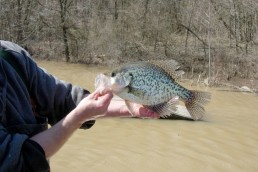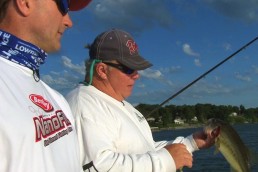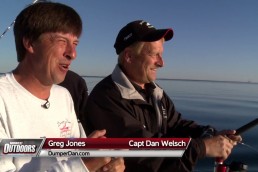Kentucky Lake Crappie Fishing
SHARE THIS POST
The weather warmed yesterday to nearly 70 degrees and we could not resist heading out to Kentucky Lake in pursuit of some crappies. There were some fish in the backs of coves and the gulls were thick in there as they seemed to have spooked the fish. What fish we did find were in about 3 feet of water near wood.
It gets you thinking about finding crappies.
Location is key, and it is dependent upon structure and water temperature. The fish seem to move about 1 foot or 1 1/2 feet for every 2 degrees of water temperature change. They also need structure to relieve tension, and underwater channels are their “roadways” as the water temperature changes and they seek different levels of comfort. Channels are like the roads on dry land, while creek channels are the “state highways” with the stream channels as “city streets.”
In the spring rising water temperatures trigger a feeding binge as fish prepare for the spawn. At 62 degrees, the males move into the spawning areas to select nests. The males select beds in only certain depths in response to the amount of light that filters through the water to the eggs.
During the spawn, the males tend the nest and the young. The females lay their eggs then move about 10 feet off the bank and a foot or so deeper. The amount of fish taken during the spawn is a heavy burden on the species, so one should practice catch and release during this period.
Once the water temperature reaches 70, the spawn will end. The stress of the spawn seems to wear them out. Anglers should fish lures slowly during the next 72 hours, as the crappies are not aggressively feeding.
As the water warms during the summer months, crappies move down and suspend rather than relate to structure. Locating fish and catching them becomes a challenge. As the water cools this process reverses. Anglers that understand the crappies’ movements are the ones that find them.
Most crappie anglers are jig fishermen. Some use live bait while others do not like live bait. Some do have difficulty in controlling its movement. Minnows move away from crappies out of fear.
Are you enjoying this post?
You can be among the first to get the latest info on where to go, what to use and how to use it!
An artificial lure will stay in place. Preferred colors are black/pearl (white), red/pearl (white), red/chartreuse, pink/pearl (white) and chartreuse/blue. Change these colors as required and count down to where the fish are taking the lure.
For consistency, hold the jigs at a specific level and use a rubber band. Once the lure is the right level to take fish, simply place the rubber band around the reel spool. Then you can reel it up and drop the lure right back to the exact same depth.
Other equipment include a cap and polarized glasses. They enable you to watch the line where it comes out of the water. And use a line that you can see because any “unnatural” line movement is a fish.
Crappies take bait at the tail first, then turn it around in their mouth before swallowing it. That is the reason crappie anglers feel a “double tic” on the line.
When you feel a tic, lift up to set the hook. That is all that is necessary with crappies since they have such soft mouth tissue. Maintain a steady pressure with the fish as you bring it to the surface.
Fishing from a boat on windy days is tricky. And flipping is good as long as you keep the lure close to the water. Anchor the back of the boat to hold it in a specific location, then use the trolling motor to move the front of the boat. It works better than trying to control the whole boat with just the trolling motor.
If the fish cease to bite, move the lure just a few inches away until you find them again. Crappies stay in the same location; they just change their view and turn around a little. The angler needs to change the angle he is using to present the lure.
Don Gasaway is a veteran outdoor writer from Marion, Ill. He may be contacted at: dongasaway.wordpress.com or facebook.com/DonsJournal.
MWO
SHARE THIS POST
Did you enjoy this post?
You can be among the first to get the latest info on where to go, what to use and how to use it!
Don Gasaway
Don Gasaway is a veteran freelance outdoor writer from Marion, Ill. He may also be found at: https://www.facebook.com/DonGasawayWriter and facebook.com/Wandering Angler. Comments are welcome



